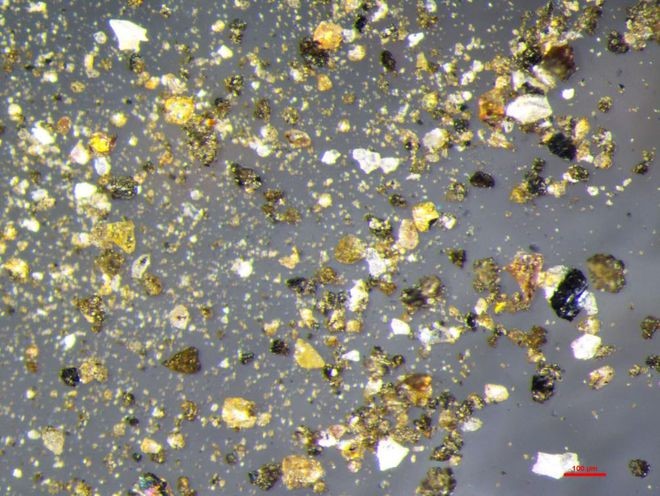China makes huge progress in studies of lunar samples
On June 25, the return capsule of China's Chang'e-6 lunar probe landed precisely in the designated area in Siziwang banner, north China's Inner Mongolia autonomous region, operating normally. The returner brought back samples collected from the moon's far side for the first time in human history, marking another milestone in China's space exploration endeavors.
On December 17, 2020, China's Chang'e-5 probe retrieved about 1,731 grams of samples from the moon - the first ever obtained from a young lunar surface region of volcanic rocks by humankind. Over the past more than three years, the China National Space Administration has distributed 85.48 grams of scientific research samples to 131 research teams in seven batches. More than 70 achievements in multiple fields have been published on important Chinese and foreign journals.

Researchers conduct experiments with lunar samples. (Photo provided by China National Nuclear Corporation)
Although the distributed lunar soil samples account for only about five percent of the collected samples, the scientific achievements cover multiple fields such as lunar formation and evolution, space weathering processes and mechanisms, and resource utilization, said an expert. Through the studies of lunar soil, mysteries of the moon are being unveiled.
According to the expert, the samples retrieved by the Chang'e-5 mission were from lunar basaltic rocks, formed when magma from the lunar mantle flowed onto the moon's surface and solidified. They record the secrets of lunar evolution.
The landing site of the Chang'e-5 spacecraft was one of the youngest mare basalts located at a mid-high latitude on the moon. Previous studies estimated the age of the landing site to be between 1 to 3 billion years, but such estimations carried significant uncertainties.
Using a high-resolution dating technique independently developed by China, a Chinese research team dated the youngest rocks on the moon at around 2 billion years in age, meaning that the period of lunar volcanism was about 800 million years longer than previously believed. This finding has also provided a crucial calibration point for the chronology of impact craters, significantly improving the accuracy of dating impact craters on celestial bodies within the inner solar system.
Based on the latest studies on lunar soil, Chinese scientists have proposed new mechanisms for the formation of young volcanoes on the moon and models for lunar thermal evolution, providing new directions and insights for future lunar exploration and research.
Lunar probes and observations over the past decade have suggested that water (OH/H2O) is widely present on the lunar surface, with polar regions having higher concentrations than equatorial regions. Besides, water ice has been found in the polar regions, undergoing dynamic changes based on the duration of sunlight exposure.

Lunar samples viewed with a microscope. (Photo provided by the Beijing Research Institute of Uranium Geology, a subsidiary of the China National Nuclear Corporation)
However, due to the lack of direct sample analysis, the origin and distribution of lunar water have been a subject of controversy.
Through infrared spectroscopy and nano-scale secondary ion mass spectrometry, a research team from the Institute of Geochemistry, the Chinese Academy of Sciences has found that lunar soil grains retain a significant amount of solar wind-derived water by studying lunar samples retrieved by the Chang'e-5 mission. According to estimates, solar wind contributed to at least 179 ppm of water content in the lunar samples gathered by the probe.
The research team also found that in the mid-latitude regions of the lunar surface, solar wind has implanted a greater quantity of water in the outer layers of lunar soil particles than previously assumed, while the high-latitude regions of the moon may contain a significant amount of potentially usable water resources. Experts said that this discovery has important implications for the future utilization of lunar water resources.
Helium-3, a potential fuel for nuclear fusion, is believed to be a promising energy source. Scientists estimate that 1 million tons of helium-3 could supply the entire Earth with sufficient clean energy for 10,000 years. It is very scarce on Earth but abundant on the moon.
By analyzing the lunar soil samples retrieved by the Chang'e-5 mission, researchers have determined the optimal temperature parameters for extracting helium-3 from lunar soil. These crucial scientific data provide a foundation for China to estimate the total amount of helium-3 resources on the moon and to explore and develop the energy source in the future.

Lunar samples are exhibited at the National Museum of China, Beijing. (People's Daily Online/Weng Qiyu)
It is reported that a research team from the Beijing Research Institute of Uranium Geology, a subsidiary of the China National Nuclear Corporation, has picked out a single-crystal particle with a radius of about 10 microns from more than 140,000 tiny lunar particles retrieved by the Chang'e-5 mission, using X-ray diffraction and other technologies. The team has also decoded the particle's crystal structure.
It has been officially approved as a new mineral by the Commission on New Minerals, Nomenclature and Classification (CNMNC) of the International Mineralogical Association (IMA), and named Changesite-(Y), a kind of phosphate mineral in columnar crystal found in lunar basalt particles.
Changesite-(Y) is the sixth new mineral discovered on the moon by humankind. The new finding has made China the third country in the world to have discovered a new mineral on the moon.
According to experts, all 10 lunar sample return missions conducted by humans by far have taken place on the near side of the moon.
The landing site of the Chang'e-6 probe was in the South Pole-Aitken Basin on the lunar far side, which is the oldest and largest impact crater on the moon. The collection of samples in this region, a historic milestone for humanity, will enhance humanity's understanding of the lunar origin and the evolution of the solar system.
Researchers said that with the studies on the lunar soil collected by Chang'e-5, they are full of expectations and confidence in studying the samples retrieved during the Chang'e-6 mission.
Photos
Related Stories
- China's Chang'e-6 mission achieves complete success
- Bearing China's lunar exploration endeavors in mind
- China sets to expand int'l cooperation in lunar exploration missions
- Returner of Chang'e-6 lunar probe opened after arrival in Beijing
- Chinese scientists anticipate Chang'e-6 samples to unravel mysteries of Moon
Copyright © 2024 People's Daily Online. All Rights Reserved.









